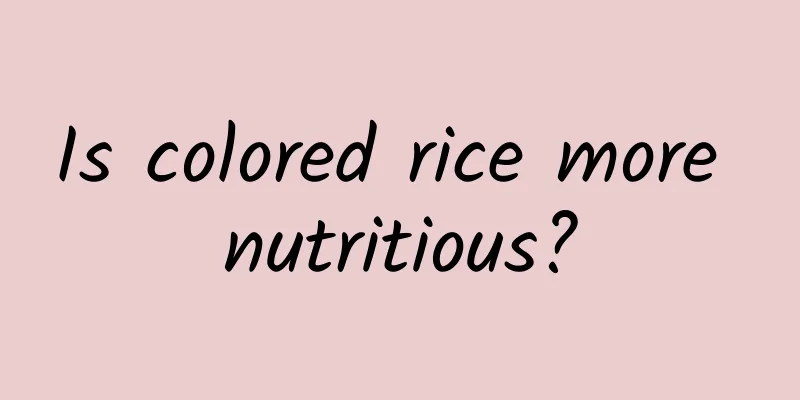Is colored rice more nutritious?

|
Many plants in nature are colorful, including fruits, vegetables, flowers, etc. A major contributor to these colorful colors is anthocyanin , one of the main coloring substances in plants. Anthocyanins are also found in rice, but are generally only found in the outer pericarp, not the inner endosperm. Depending on the amount of anthocyanins accumulated in the pericarp, rice will appear in different colors, such as red, purple, and black. These are the common red and black rice we see. The color of anthocyanins changes with the pH of the surrounding medium, turning red when exposed to acid and blue when exposed to alkali [1]. 01 What is the difference between colored rice and white rice? Colored rice is essentially brown rice with color. Its nutritional characteristics are closer to those of ordinary brown rice and better than ordinary white rice. We have already said a lot about brown rice, including providing more dietary fiber and vitamins, controlling weight, and maintaining blood sugar stability, so I will not repeat it here. In addition, in the comparative analysis, the researchers also found that although there are differences in the content of ingredients among different varieties of colored rice, compared with ordinary brown rice, colored rice often has more protein, fat, dietary fiber, vitamins and trace elements. Comparison of nutritional content of colored rice and white rice. Data is for reference only and may vary between varieties. [2] The content of trace elements in colored rice may be related to the characteristics of anthocyanins. Anthocyanins have the property of complexing with metal elements such as calcium, magnesium, iron, and aluminum, which makes the mineral content in colored rice higher than that in ordinary white rice [1]. In addition to the above, a major feature of colored rice is that it contains rich functional ingredients such as anthocyanins . 02 What is special about anthocyanins? Anthocyanin, also known as flower pigment, is the main flavonoid compound in colored rice (red rice also contains a substance called proanthocyanidin, which can be converted into anthocyanin in the body). Free anthocyanin is not stable and often combines with glucose, arabinose or galactose to form anthocyanin . Anthocyanin is a water-soluble pigment with powerful antioxidant and free radical scavenging functions, and thus has important physiological functions including anti-cancer, anti-inflammation, and cholesterol-lowering. 1. Antioxidant Anthocyanins belong to the class of bioflavonoids, and one of the most important physiological activities of flavonoids is free radical scavenging and antioxidant capacity . Anthocyanins are one of the most effective antioxidant components in flavonoids, and their antioxidant capacity far exceeds that of common vitamin E, vitamin C, catechins, and quercetin [3]. In addition, anthocyanins can reduce oxidative stress damage by increasing the activity of superoxide dismutase and glutathione converting enzyme in cells. 2. Inhibit inflammatory response Inflammatory response is closely related to the occurrence and development of many chronic diseases, such as obesity, atherosclerosis and malignant tumors. Anthocyanins can play an anti-inflammatory role by inhibiting the inflammatory response signal pathway and reducing the expression of inflammatory factors. Studies have shown that for healthy people, high doses of anthocyanin intake (300 mg/d) can reduce the release of inflammatory factors. For patients with stable coronary heart disease, daily supplementation with anthocyanin-rich black rice peel for 6 months significantly reduced the level of inflammatory factors [3]. 3. Lowering blood lipids People have long found that consuming some fruits with high anthocyanin content in the diet is very helpful in reducing the risk of coronary heart disease. So, can switching to rice containing anthocyanin have the same effect? Wu et al. have demonstrated in animal experiments that under the same conditions, black rice is more effective in lowering blood lipids than white brown rice. This difference suggests that functional ingredients such as anthocyanins play an important role in the process of lowering blood lipids [4]. 4. Prevention of chronic diseases Anthocyanins can reduce the risk of type 2 diabetes and cardiovascular disease. Epidemiological prospective studies have found that anthocyanin intake is negatively correlated with the risk of type 2 diabetes and cardiovascular disease, and higher anthocyanin intake can significantly reduce the incidence and mortality of coronary heart disease. For people at high risk of cardiovascular disease or patients with cardiovascular disease, dietary supplementation with certain anthocyanins can improve the patient's risk of disease [3]. 5. Improves vision As early as 1964, French scholars discovered that anthocyanins in blackberry can help improve people's vision at night. In 1984, doctors found that anthocyanins can improve the vision of patients with dark vision disorders. Moreover, in healthy people, anthocyanins can also help lower the dark adaptation threshold of subjects and improve visual fatigue [3]. 6. Control your weight On the one hand, colored rice is generally higher in dietary fiber than white rice; the effects of dietary fiber in reducing hunger and increasing satiety have been well documented. On the other hand, polyphenols in colored rice have the effect of inhibiting fat absorption. Callcott et al. compared the anti-fat properties of polyphenol extracts from colored rice and found that polyphenol extracts significantly reduced lipid accumulation in adipocytes and downregulated the expression of PPARg[5]. Another Korean study compared the effects of eating white rice, brown rice, and black rice on 40 overweight women over a six-week period and found that those who ate brown rice/black rice lost significantly more weight and had lower BMI and body fat percentage than those who ate white rice. This suggests that both brown rice and black rice can be effectively used as a dietary therapy for obese women****[6]. 03 How much anthocyanin should be consumed to be effective? The specific recommended value for anthocyanin intake recommended by the Chinese Nutrition Society is 50 mg/d. Reaching or exceeding this value has a significant effect on increasing good cholesterol (HDL-C) and promoting health [3]. How much anthocyanin does the Chinese population consume every day? According to a study in Guangdong, the anthocyanin intake of the population is 43.1 mg/d[1]. Considering that the intake of vegetables, fruits and whole grains by Chinese residents is insufficient, it is recommended that people choose more dark-colored foods, and replace white rice with more colored brown rice such as black rice and red rice. Anthocyanin content in common foods (mg/100g edible part) | Reference 3 The above picture shows the content of anthocyanins in common foods. It can be seen that the anthocyanin content in black rice is second only to mulberries, as high as 622.68 mg . It is a very good source of anthocyanins and it is recommended to eat more in your daily diet. Let me mention the safety of anthocyanins. It is a very safe substance. So far, no one has been found to have safety problems due to excessive intake of anthocyanins in the diet, so under normal diet conditions, there is no need to worry about overeating. Some people may have this question: Since colored rice has higher nutritional value, why do we generally eat white rice instead of colored rice? This is because the genes that control anthocyanin synthesis carried by colored rice are closely linked to the genes that control seed shed and dormancy. During the process of cultivation and domestication, humans discovered that colored varieties are prone to grain shed and have low germination rates. As a result, many colored varieties have gradually been eliminated, and white rice has remained to become the main cultivated rice and has gradually dominated the dining table. After people learned about the benefits of colored rice, breeding experts began to screen and cultivate colored rice varieties with excellent traits, realizing the production and application of black rice, red rice, etc., which we can eat. Colored brown rice is now very common in the market. For example, there are multi-colored brown rice that is specially made of brown rice, red rice, black rice, etc. They are beautiful, delicious and nutritious, and there are many ways to cook them. You can use your imagination to make all kinds of high-value delicacies. Today I will recommend a few ways to eat them! 04 The magical way to eat colored rice 1. Colorful brown rice risotto The multi-colored brown rice is sweet and delicious, and can be flexibly matched with a variety of ingredients according to your preferences and customized. If you want to experience the exotic flavor, stir-fry the cooked brown rice with potatoes and chicken pieces, pour rich curry sauce on it, and a bowl of Thai spices and potato aroma is ready. If you want to taste traditional Cantonese cuisine, you can cleverly combine brown rice with Cantonese sausage. After steaming, the brown rice absorbs the rich aroma of the sausage and the sweetness of the wine, creating a Cantonese sausage brown rice that balances taste buds and health. 2. Brown rice yogurt After the cooked multi-colored brown rice cools down, gently mix it with yogurt, add fruits, nuts or honey for flavoring, and create a healthy combination of dietary fiber, minerals, protein and probiotics. The chewy texture of brown rice and the smooth texture of yogurt are a simple combination that gives you a multi-layered taste, making it a healthy dessert with a high appearance. 3. Multi-colored brown rice sushi The cooled multi-colored brown rice is poured with sushi vinegar and wrapped in nori. It is paired with a variety of fresh seafood and vegetables to create a colorful sushi roll that is both nutritious and delicious. 4. Colorful Brown Rice Salad Mix multi-colored brown rice with fruits, vegetables, shrimp, soy products, nuts and other ingredients, and use your favorite sauce to make a salad feast that combines nutrition and deliciousness. In addition to the rich colors that stimulate appetite, it also provides a balanced nutritional combination of high-quality carbohydrates, high-quality proteins, vitamins and minerals needed by the human body. References: [1] Li Lijun et al. Health functions and research status of colored rice[J]. Guangdong Agricultural Sciences, 2012, 39(21):11-13+17. |
>>: What does the new edible battery taste like? Crunchy chicken?
Recommend
QUICK FactSet: Tesla's net profit per vehicle reached 50,000 yuan, ranking first among global automakers
A media outlet studied the profits of the world&#...
Astronauts are not allowed to fart. How can they do this?
The environment in space is completely different ...
Cat meme video goes viral! What is the magic of this video for young people?
Recently, various official accounts have been pos...
How much does Baidu promotion cost? How to calculate Baidu promotion cost?
It depends on the specific word being promoted. T...
Take you to understand the design details of the Chinese space station cabin
February 10, 00:16 The Shenzhou 15 astronaut crew...
WeChat chat history backup is charged? Teach you how to migrate chat history for free, the method is very simple
WeChat has been trending recently, and may launch...
Aiti Tribe Story Collection (25): Analysis of Chain Storage Stack and Code Implementation
[51CTO.com original article] Xiao Yao graduated f...
Bidding hosting, what are the advantages of finding a professional company to do bidding hosting?
With the rapid development of Internet technology...
10,000-word article | In-depth analysis of the promotion and operation strategy behind Douyin
Since I started my content entrepreneurship , I h...
The fierce competition between the two brightest minds made the chemical bond theory compatible [Part 1]
How atoms connect to form molecules is the primar...
Is it wrong to fold the quilt immediately after getting up? How many of these "hygiene" misunderstandings in life have you fallen into?
Is it wrong to fold the quilt immediately after g...
[High-end boutique] Kuaishou unmanned live broadcast mobile version sold for 588 [live broadcast script + software operation tutorial]
[High-end boutique] Kuaishou unmanned live broadc...
QQ update! The new function is simple and crude, no longer worry about voice being eavesdropped
Report! Tencent is here again, bringing the lates...
Which one is better, Alipay Mini Program or WeChat Mini Program?
It is understood that the Alipay mini program wil...









